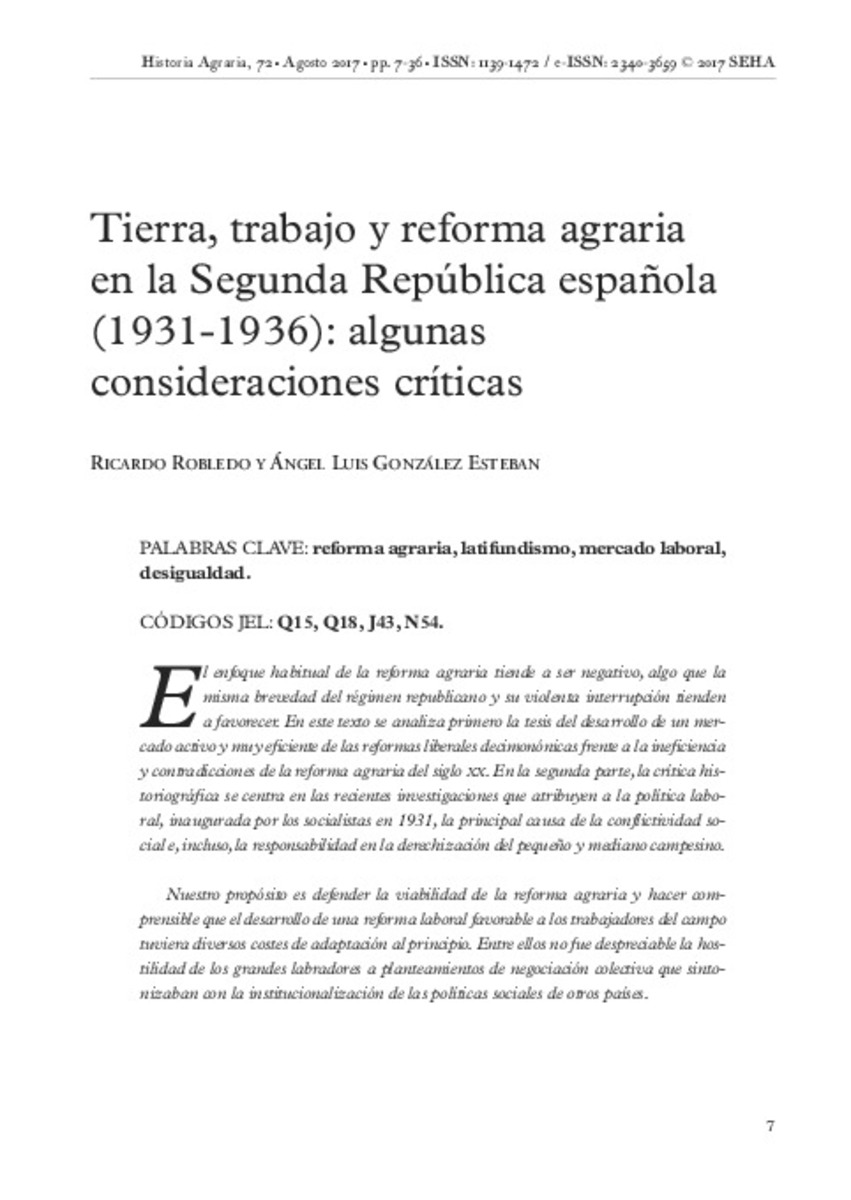Mostrar el registro sencillo del ítem
Tierra, trabajo y reforma agraria en la Segunda República española (1931-1936): algunas consideraciones críticas
| dc.contributor.author | Robledo, Ricardo | |
| dc.contributor.author | González Esteban, Ángel Luis | |
| dc.date.accessioned | 2018-03-04T08:39:16Z | |
| dc.date.available | 2018-03-04T08:39:16Z | |
| dc.date.issued | 2017-08 | |
| dc.identifier.issn | 1139-1472 | |
| dc.identifier.uri | http://hdl.handle.net/10234/173181 | |
| dc.description.abstract | El enfoque habitual de la reforma agraria tiende a ser negativo, algo que la misma brevedad del régimen republicano y su violenta interrupción tienden a favorecer. En este texto se analiza primero la tesis del desarrollo de un mercado activo y muy eficiente de las reformas liberales decimonónicas frente a la ineficiencia y contradicciones de la reforma agraria del siglo xx. En la segunda parte, la crítica historiográfica se centra en las recientes investigaciones que atribuyen a la política laboral, inaugurada por los socialistas en 1931, la principal causa de la conflictividad social e, incluso, la responsabilidad en la derechización del pequeño y mediano campesino. Nuestro propósito es defender la viabilidad de la reforma agraria y hacer comprensible que el desarrollo de una reforma laboral favorable a los trabajadores del campo tuviera diversos costes de adaptación al principio. Entre ellos no fue despreciable la hostilidad de los grandes labradores a planteamientos de negociación colectiva que sintonizaban con la institucionalización de las políticas sociales de otros países. | ca_CA |
| dc.description.abstract | The brief existence of the Second Republic and its violent end tend to favor the usual negative view of land reform. This article analyzes the perceptions of inefficiency and contradictory effects of the twentieth-century agr icultural reform, in contrast with the thesis of an active and extremely efficient market following the liberal refor ms of the nineteenth century. The second part of the paper focuses on recent historiographical research that considers the main cause of pre-Civil War social unrest to have been the labor polic y launched by the Socialists in 1931, which was also seen as a decisive factor in the swing towards the right of mid- and small-scale far mers. This article defends the viability of an agricultural reform that proved beneficial for the average farm worker. The initial costs of adaptation to the reform are explained, along with the hostility of Spain’s large-scale farmers to collective bargaining, an approach which had been institutionalized elsewhere through social policies. | ca_CA |
| dc.format.extent | 30 p. | ca_CA |
| dc.format.mimetype | application/pdf | ca_CA |
| dc.language.iso | spa | ca_CA |
| dc.publisher | Sociedad Española de Historia Agraria (SEHA) | ca_CA |
| dc.relation.isPartOf | Historia agraria: Revista de agricultura e historia rural, nº 72, 7-36 | ca_CA |
| dc.rights | © 2017 SEHA | ca_CA |
| dc.rights | Attribution-NonCommercial-NoDerivatives 4.0 Internacional | * |
| dc.rights.uri | http://creativecommons.org/licenses/by-nc-nd/4.0/ | * |
| dc.subject | Reforma agraria | ca_CA |
| dc.subject | Agrarian reform | ca_CA |
| dc.subject | Mercado laboral | ca_CA |
| dc.subject | Labour market | ca_CA |
| dc.subject | Latifundismo | ca_CA |
| dc.subject | Latifundia | ca_CA |
| dc.subject | Desigualdad | ca_CA |
| dc.subject | Inequality | ca_CA |
| dc.title | Tierra, trabajo y reforma agraria en la Segunda República española (1931-1936): algunas consideraciones críticas | ca_CA |
| dc.type | info:eu-repo/semantics/article | ca_CA |
| dc.subject.jel | Q15 | ca_CA |
| dc.subject.jel | Q18 | ca_CA |
| dc.subject.jel | J43 | ca_CA |
| dc.subject.jel | N54 | ca_CA |
| dc.rights.accessRights | info:eu-repo/semantics/openAccess | ca_CA |
| dc.relation.publisherVersion | http://www.historiaagraria.com/numero.php?n=72 | ca_CA |








